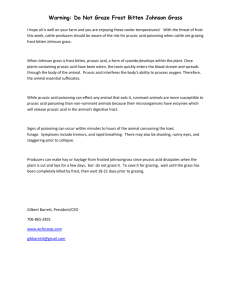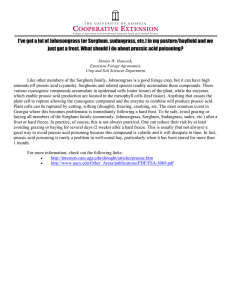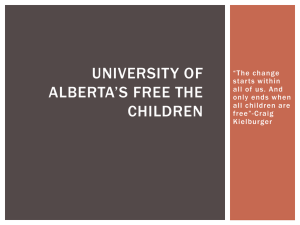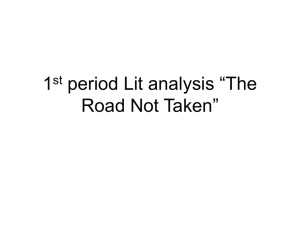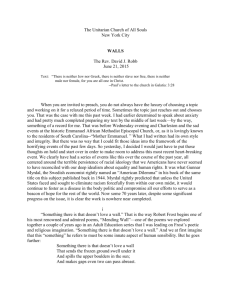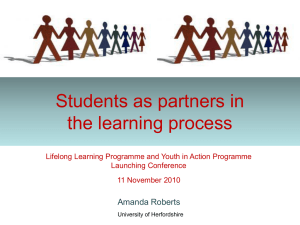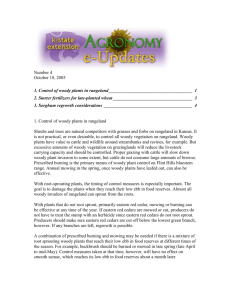Prussic Acid Poisoning Potential in Frosted Forages
advertisement
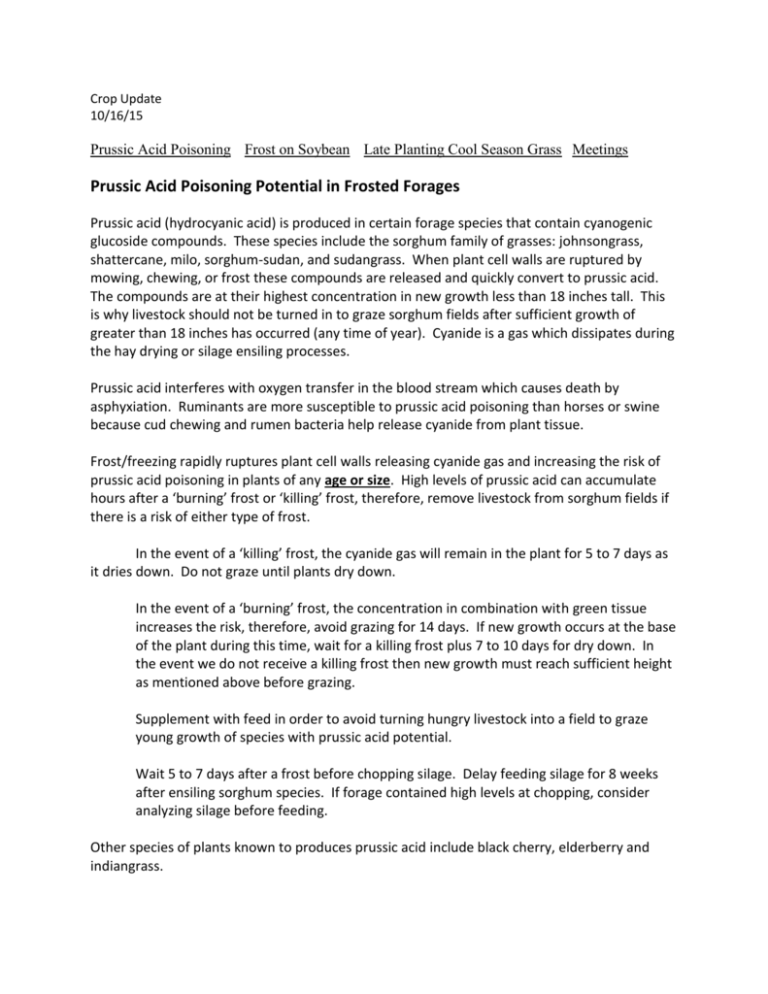
Crop Update 10/16/15 Prussic Acid Poisoning Frost on Soybean Late Planting Cool Season Grass Meetings Prussic Acid Poisoning Potential in Frosted Forages Prussic acid (hydrocyanic acid) is produced in certain forage species that contain cyanogenic glucoside compounds. These species include the sorghum family of grasses: johnsongrass, shattercane, milo, sorghum-sudan, and sudangrass. When plant cell walls are ruptured by mowing, chewing, or frost these compounds are released and quickly convert to prussic acid. The compounds are at their highest concentration in new growth less than 18 inches tall. This is why livestock should not be turned in to graze sorghum fields after sufficient growth of greater than 18 inches has occurred (any time of year). Cyanide is a gas which dissipates during the hay drying or silage ensiling processes. Prussic acid interferes with oxygen transfer in the blood stream which causes death by asphyxiation. Ruminants are more susceptible to prussic acid poisoning than horses or swine because cud chewing and rumen bacteria help release cyanide from plant tissue. Frost/freezing rapidly ruptures plant cell walls releasing cyanide gas and increasing the risk of prussic acid poisoning in plants of any age or size. High levels of prussic acid can accumulate hours after a ‘burning’ frost or ‘killing’ frost, therefore, remove livestock from sorghum fields if there is a risk of either type of frost. In the event of a ‘killing’ frost, the cyanide gas will remain in the plant for 5 to 7 days as it dries down. Do not graze until plants dry down. In the event of a ‘burning’ frost, the concentration in combination with green tissue increases the risk, therefore, avoid grazing for 14 days. If new growth occurs at the base of the plant during this time, wait for a killing frost plus 7 to 10 days for dry down. In the event we do not receive a killing frost then new growth must reach sufficient height as mentioned above before grazing. Supplement with feed in order to avoid turning hungry livestock into a field to graze young growth of species with prussic acid potential. Wait 5 to 7 days after a frost before chopping silage. Delay feeding silage for 8 weeks after ensiling sorghum species. If forage contained high levels at chopping, consider analyzing silage before feeding. Other species of plants known to produces prussic acid include black cherry, elderberry and indiangrass. One to two days after a hard frost, legumes have an increased risk of causing bloat, especially when grazing pure legume stands. Wait until the legume begins to dry from frost damage. Back to Top Frost Risk to Soybean The potential for frost in some parts of the region this weekend, has raised some concerns on soybean yield. Generally, temperatures dropping below 30 degrees F for any length of time will damage all plant parts. Frost from temperatures above 30 degrees will typically damage upper canopy leaves. Frost damage begins as water soaked areas on leaves that later turn brown. Soybeans at the R7 stage of development (one yellow pod over 50% of plant population) are at the least level of risk from a frost or freeze and loss is generally minor. Soybeans in the R6 stage of development (swollen green beans in green pods) can sustain damage depending on duration of freezing temperature, usually more loss associated with quality than quantity. R6 soybeans that sustain frost or freeze damage can have a shriveled seed coat and can retain the green color, which potentially can become lighter over time if stored. Soybeans in early stages than R6 can sustain significant losses, especially if temperatures fall enough to result in complete foliage loss. If a soybean field sustains severe frost/freeze damage soybeans should be harvested between 16% and 18% moisture and then dried to below 13% for safe storage. Shatter loss can increase in frost/freeze damaged soybeans when allowed to field dry below 16%. Frost damaged soybeans will probably be more difficult to harvest; therefore, combine threshing adjustments may need to be made. Back to Top Establishing Cool Season Grass – How Late? With the dry weather, there have been some questions about late planting cool season grass. The recommended time frame for cool season grass, such as novel endophyte fescue, establishment is September through mid-October. The concern with planting outside this window is not so much germination but root development. Cool season grass, much like cereal grains, will germinate at soil temps of 50 degrees F or higher. Germination can occur at a slightly lower temperature, but is not practical due to prolonged emergence issues. The concern with late planting is providing enough time for shoot emergence, growth and carbohydrate supply for root development. Cool season grass maximum root growth is between 50 and 65 degrees F, however, roots will continue to grow slowly until the soil freezes. Shoot growth will slow and eventually stop as temperatures consistently remain below 50 degrees F. Therefore, there must be a balance of enough shoot growth to support enough root growth to avoid winter heaving. For Southeast Missouri, this planting window may be extended if November is favorable for emergence and shoot growth to supply needed energy for root development which is all dependent on good soil moisture going into the winter. Keep in mind that under ideal conditions it takes cool season perennial grass such as fescue 7 to 14 days to emerge. If this fall continues to be dry and planting is delayed, an alternative is to consider an annual cereal grain which can have more success of establishment in late fall or early spring followed by planting a warm season annual grass for summer. Back to Top University of Missouri Fisher Delta Center Certified Crop Advisors Meeting A two-day Certified Crop Advisor program will be conducted at the University of Missouri Fisher Delta Research Center in Portageville, Missouri on November 23 and 24, 2015. Separate sessions in Pest Management and Crop Production will be offered on Monday, November 23rd. Separate sessions in Soil Fertility and Soil and Water will be offered on Tuesday, November 24th. Each session will offer 4 CEU’s. Classes will begin at 8:00 a.m. each day. Registration will be $50 per session or $180 for all four which will include lunch. For more details or specific needs, contact David Dunn (573-379-5431, dunnd@missouri.edu) or Anthony Ohmes (573-243-3581, ohmesg@missouri.edu). Upcoming University of Missouri Production Meetings Livestock and Forage Meeting – November 12th, Marble Hill, MO 6:00 pm to 9:00 pm Contact Susan Fisher at the Bollinger County Extension office (fishersl@missouri.edu or (573) 238-2420 See attached flyer: Corn Meeting – December 9th at the Miner Convention Center, Miner, MO 8:00 am to 1:00 pm Guest speakers include Dr. Chad Lee, University of Kentucky Contact myself or David Reinbott to register. Soybean Meeting – January 12th at the Miner Convention Center, Miner, MO 8:00 am to 1:00 pm Contact myself or David Reinbott to register. Anthony Ohmes University of Missouri Extension Southeast Region 573-243-3582 http://extension.missouri.edu/capegirardeau
